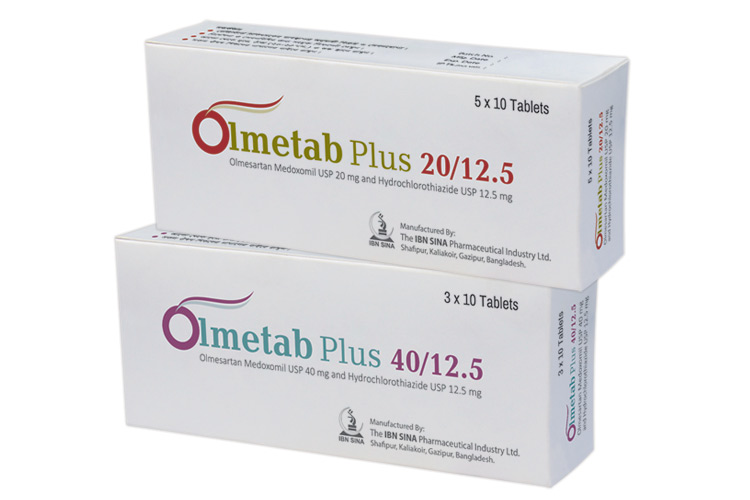
OLMETAB PLUS
OLMESARTAN MEDOXOMIL USP + HYDROCHLOROTHIAZIDE USP
| NAME | STRENGTH | PACK SIZE | DOSAGE FORM |
|---|---|---|---|
| OLMETAB PLUS 20/12.5 MG | 20/12.5 MG | 50 S | TABLET |
| OLMETAB PLUS 40/12.5 MG | 40/12.5 MG | 30 S | TABLET |
Olmetab Plus 20/12.5 Tablet: Each tablet contains Olmesartan Medoxomil USP 20 mg and Hydrochlorothiazide USP 12.5 mg.
Olmetab Plus 40/12.5 Tablet: Each tablet contains Olmesartan Medoxomil USP 40 mg and Hydrochlorothiazide USP 12.5 mg.
It is a combination preparation of Olmesartan Medoxomil and Hydrochlorothiazide. Olmesartan Medoxomil, a prodrug, is hydrolyzed to Olmesartan during absorption from the gastrointestinal tract. Olmesartan is a selective angiotensin II receptor (AT1 subtype) antagonist. It blocks the actions of angiotensin II mediated by the AT1 receptor, regardless of the source or route of synthesis of angiotensin II.
Hydrochlorothiazide is a thiazide diuretic. Hydrochlorothiazide reduces plasma volume with consequent increase in plasma renin activity, increases aldosterone secretion & urinary Potassium loss and decreases serum Potassium. The renin-aldosterone link is mediated by angiotensin II. So, co-administration of an angiotensin II receptor antagonist (like-Olmesartan Medoxomil) with diuretics tends to reverse the Potassium loss associated with these diuretics.
Olmetab Plus is indicated for the treatment of hypertension. This combination preparation is indicated in patients whose blood pressure is not adequately controlled on Olmesartan alone. It is not indicated for initial therapy.
Adult: Dosage must be individualized. The usual recommended starting dose is one tablet of 20/12.5 mg Olmesartan/ Hydrochlorothiazide once daily. Depending on the blood pressure response, the dose may be titrated at after 2 to 4 weeks as needed to a maximum dose of 40/25 mg Olmesartan/Hydrochlorothiazide.
Elderly and renal impairment: In elderly patients the same dosage of the combination is recommended as for adults. No dosage adjustment is necessary in patients with mild to moderate renal impairment (Creatinine clearance is 30 ml/min, < 60 ml/min). In patients with more severe renal impairment, loop diuretics are preferred to thiazides, so this is not recommended.
Children and adolescents: This combination is not recommended for use in children below 18 years due to a lack of data on safety and efficacy.
This combination is contraindicated in patients who are hypersensitive to any component of this product.
All patients receiving thiazide therapy should be observed for clinical signs of fluid or electrolyte imbalance: hyponatremia, hypochloremic alkalosis and hypokalemia. Hypokalemia may develop, especially with rapid diuresis, when severe cirrhosis is present, or after prolonged therapy. As a consequence of inhibiting the renin-angiotensin-aldosterone system, changes in renal function may be anticipated in susceptible individuals treated with Olmesartan.
Treatment with Olmesartan and Hydrochlorothiazide is well tolerated, with an incidence of adverse events similar to placebo. Events generally were mild, transient and had no relationship to the dose of Olmesartan-Hydrochlorothiazide, such as vertigo, coughing, back pain, rash, weakness, transient blurred vision, diarrhea, headache, and urinary tract infection.
Pregnancy: Pregnancy category C (first trimester) and D (second and third trimesters). Olmesartan should not be used during pregnancy. When pregnancy is detected, it should be discontinued as soon as possible.
Lactation: It is not known whether Olmesartan is excreted in human milk, but Olmesartan is secreted at low concentration in the milk of lactating rats. Thiazides appear in human milk. Because of the potential for adverse effects on the nursing infant, a decision should be made whether to discontinue nursing or discontinue the drug, taking into account the importance of the drug to the mother.
No significant drug interactions were reported when Olmesartan was co-administered with Hydrochlorothiazide, Digoxin or Warfarin. The bioavailability of Olmesartan was not significantly altered by the co-administration of antacids. Olmesartan is not metabolized by the Cytochrome P450 system and has no effects on P450 enzymes; thus, interactions with drugs that inhibit, induce or are metabolized by those enzymes are not expected. Hydrochlorothiazide may cause orthostatic hypotension when administered concurrently with Alcohol, Barbiturates or Narcotics. Lithium should not generally be given with diuretics. NSAIDs can reduce the diuretic, natriuretic and antihypertensive effects of loop, potassium-sparing and thiazide diuretics.
Limited data are available related to overdosage in humans. The most likely manifestations of overdosage would be hypotension and tachycardia; bradycardia could be encountered if parasympathetic (vagal) stimulation occurs. If symptomatic hypotension occurs, initiate supportive treatment. The dialyzability of Olmesartan is unknown.
Store in a cool (at 20-25°C) and dry place, protect from light and moisture. Keep out of the reach of children.
Olmetab Plus 20/12.5 Tablet: Each box contains 5 x 10's tablet in Alu-Alu blister pack.
Olmetab Plus 40/12.5 Tablet: Each box contains 3 x 10's tablet in Alu-Alu blister pack.
